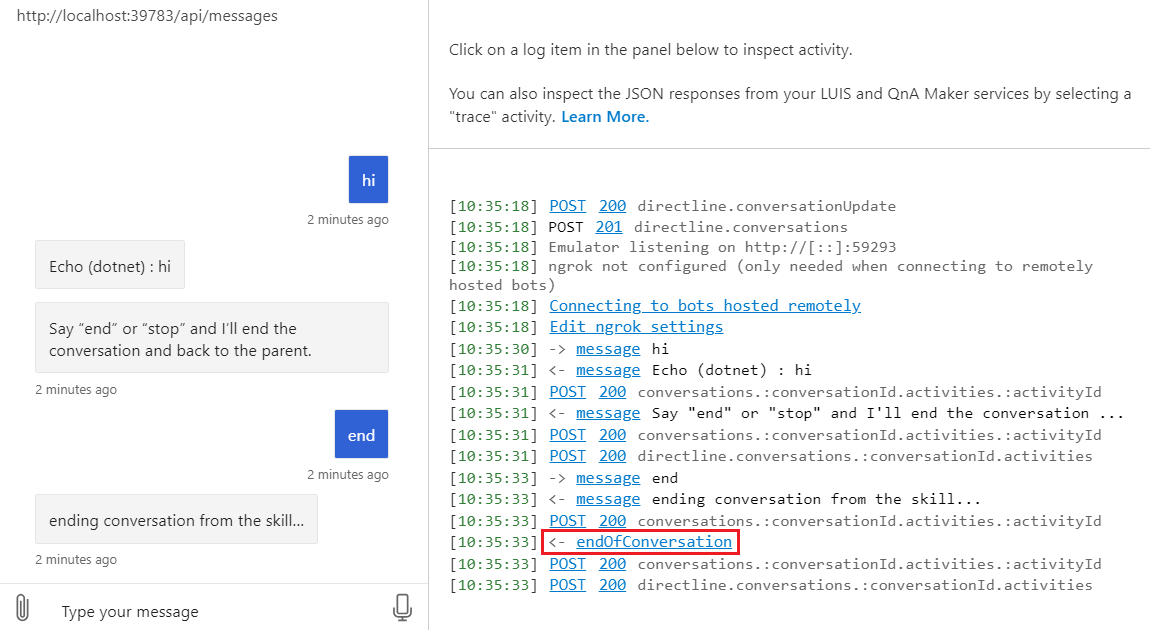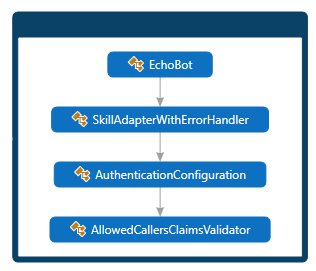Implementowanie umiejętności
DOTYCZY: SDK w wersji 4
Możesz użyć umiejętności, aby rozszerzyć innego bota. Umiejętność to bot, który może wykonywać zestaw zadań dla innego bota.
- Manifest opisuje interfejs umiejętności. Deweloperzy, którzy nie mają dostępu do kodu źródłowego umiejętności, mogą używać informacji w manifeście, aby zaprojektować swojego konsumenta umiejętności.
- Umiejętność może używać weryfikacji oświadczeń do zarządzania dostępem botów lub użytkowników do niej.
W tym artykule pokazano, jak zaimplementować umiejętność, która odzwierciedla dane wejściowe użytkownika.
Niektóre typy konsumentów umiejętności nie mogą używać niektórych typów botów umiejętności. W poniższej tabeli opisano, które kombinacje są obsługiwane.
| Obsługa wielu najemców | Umiejętność dedykowana jednemu najemcy | Umiejętność związana z tożsamością zarządzaną nadaną przez użytkownika | |
|---|---|---|---|
| Użytkownik z wieloma dzierżawami | Obsługiwane | Niewspierane | Nieobsługiwane |
| Jednodzierżawowy użytkownik | Niewspierane | Obsługiwane, jeśli obie aplikacje należą do tego samego dzierżawcy | Obsługiwane, jeśli obie aplikacje należą do tego samego dzierżawcy |
| Odbiorca zarządzanej tożsamości przypisanej przez użytkownika | Nieobsługiwane | Obsługiwane, jeśli obie aplikacje należą do tego samego dzierżawcy | Obsługiwane, jeśli obie aplikacje należą do tego samego klienta. |
Uwaga
Zestawy SDK języka JavaScript, C# i Python platformy Bot Framework będą nadal obsługiwane, jednak zestaw SDK języka Java jest wycofywany z ostatecznym długoterminowym wsparciem kończącym się w listopadzie 2023 r.
Istniejące boty utworzone za pomocą zestawu JAVA SDK będą nadal działać.
W przypadku tworzenia nowych botów, rozważ użycie programu Microsoft Copilot Studio i przeczytaj o wyborze odpowiedniego rozwiązania dla Copilota.
Aby uzyskać więcej informacji, zobacz Przyszłość tworzenia botów.
Wymagania wstępne
- Znajomość podstaw bota i umiejętności.
- Subskrypcja platformy Azure (w celu wdrożenia umiejętności). Jeśli nie masz subskrypcji, przed rozpoczęciem utwórz bezpłatne konto.
- Kopia prostego przykładu bota do bota w języku C#, JavaScript, Java lub Python.
Uwaga
Począwszy od wersji 4.11, nie potrzebujesz identyfikatora aplikacji i hasła, aby przetestować umiejętności lokalnie w emulatorze bot framework. Subskrypcja platformy Azure jest nadal wymagana do wdrożenia umiejętności na platformie Azure.
Informacje o tym przykładzie
Przykład prostych umiejętności do komunikacji między botami obejmuje projekty dla dwóch botów:
- Bot echo skill, który implementuje tę umiejętność.
- Prosty root bot, który implementuje bota głównego wykorzystującego umiejętności.
Ten artykuł koncentruje się na umiejętności, która obejmuje logikę obsługi w jego bocie i adapterze.
Aby uzyskać informacje na temat prostego bota podstawowego, zobacz, jak zaimplementować konsumenta umiejętności.
Zasoby
W przypadku wdrożonych botów uwierzytelnianie bot-to-bot wymaga, aby każdy uczestniczący bot miał prawidłowe informacje o tożsamości. Możesz jednak przetestować wielodostępne umiejętności i umiejętności konsumentów lokalnie za pomocą emulatora bez identyfikatora aplikacji i hasła.
Aby udostępnić umiejętności botom dostępnym dla użytkowników, zarejestruj umiejętności na platformie Azure. Aby uzyskać więcej informacji, zobacz jak zarejestrować bota w usłudze Azure AI Bot Service.
Konfiguracja aplikacji
Opcjonalnie dodaj informacje o tożsamości umiejętności do pliku konfiguracji. Jeśli albo umiejętność, albo jej użytkownik dostarcza informacje o tożsamości, oboje muszą to zrobić.
Tablica dozwolonych rozmówców może ograniczyć, którzy konsumenci umiejętności mogą uzyskiwać do niej dostęp. Aby zaakceptować wywołania od dowolnego użytkownika zasobu, dodaj element "*".
Uwaga
Jeśli testujesz umiejętności lokalnie bez informacji o tożsamości bota, ani umiejętności, ani użytkownik umiejętności nie uruchamia kodu w celu przeprowadzenia weryfikacji oświadczeń.
EchoSkillBot\appsettings.json
Opcjonalnie dodaj informacje o tożsamości umiejętności do pliku appsettings.json.
{
"MicrosoftAppType": "",
"MicrosoftAppId": "",
"MicrosoftAppPassword": "",
"MicrosoftAppTenantId": "",
// This is a comma separate list with the App IDs that will have access to the skill.
// This setting is used in AllowedCallersClaimsValidator.
// Examples:
// [ "*" ] allows all callers.
// [ "AppId1", "AppId2" ] only allows access to parent bots with "AppId1" and "AppId2".
"AllowedCallers": [ "*" ]
}
Logika obsługi działań
Aby zaakceptować parametry wejściowe
Użytkownik umiejętności może wysyłać informacje do umiejętności. Jednym ze sposobów akceptowania takich informacji jest akceptowanie ich za pośrednictwem właściwości value w komunikatach przychodzących. Innym sposobem jest obsługa zdarzeń i wywoływanie działań.
Umiejętność w tym przykładzie nie akceptuje parametrów wejściowych.
Aby kontynuować lub ukończyć konwersację
Gdy umiejętność wysyła działanie, odbiorca umiejętności powinien przekazać działanie użytkownikowi.
Jednak musisz wysłać endOfConversation działanie po zakończeniu umiejętności. W przeciwnym razie użytkownik umiejętności nadal przekazuje działania użytkownika do umiejętności.
Opcjonalnie użyj właściwości value działania, aby uwzględnić wartość zwracaną, i użyj właściwości code działania, aby wskazać, dlaczego umiejętność się kończy.
EchoSkillBot\Bots\EchoBot.cs
protected override async Task OnMessageActivityAsync(ITurnContext<IMessageActivity> turnContext, CancellationToken cancellationToken)
{
if (turnContext.Activity.Text.Contains("end") || turnContext.Activity.Text.Contains("stop"))
{
// Send End of conversation at the end.
var messageText = $"ending conversation from the skill...";
await turnContext.SendActivityAsync(MessageFactory.Text(messageText, messageText, InputHints.IgnoringInput), cancellationToken);
var endOfConversation = Activity.CreateEndOfConversationActivity();
endOfConversation.Code = EndOfConversationCodes.CompletedSuccessfully;
await turnContext.SendActivityAsync(endOfConversation, cancellationToken);
}
else
{
var messageText = $"Echo: {turnContext.Activity.Text}";
await turnContext.SendActivityAsync(MessageFactory.Text(messageText, messageText, InputHints.IgnoringInput), cancellationToken);
messageText = "Say \"end\" or \"stop\" and I'll end the conversation and back to the parent.";
await turnContext.SendActivityAsync(MessageFactory.Text(messageText, messageText, InputHints.ExpectingInput), cancellationToken);
}
}
Aby anulować umiejętność
W przypadku umiejętności obejmujących wiele kolei możesz również zaakceptować endOfConversation działania od konsumenta umiejętności, aby umożliwić konsumentowi anulowanie bieżącej konwersacji.
Logika tej umiejętności nie zmienia się z tury na turę. Jeśli zaimplementujesz umiejętność przydzielającą zasoby konwersacji, dodaj kod oczyszczania zasobów do procedury obsługi zakończenia konwersacji.
EchoSkillBot\Bots\EchoBot.cs
protected override Task OnEndOfConversationActivityAsync(ITurnContext<IEndOfConversationActivity> turnContext, CancellationToken cancellationToken)
{
// This will be called if the root bot is ending the conversation. Sending additional messages should be
// avoided as the conversation may have been deleted.
// Perform cleanup of resources if needed.
return Task.CompletedTask;
}
Moduł sprawdzania poprawności oświadczeń
W tym przykładzie użyto listy dozwolonych wywołań na potrzeby weryfikacji oświadczeń. Plik konfiguracji umiejętności definiuje listę. Następnie obiekt modułu sprawdzania poprawności odczytuje listę.
Do konfiguracji uwierzytelniania należy dodać moduł sprawdzania poprawności oświadczeń. Oświadczenia są oceniane po nagłówku uwierzytelniania. Kod weryfikacji powinien zgłosić błąd lub wyjątek, aby odrzucić żądanie. Istnieje wiele powodów, dla których można odrzucić w inny sposób uwierzytelnione żądanie. Na przykład:
- Umiejętność jest częścią płatnej usługi. Użytkownik, który nie znajduje się w bazie danych, nie powinien mieć dostępu.
- Umiejętność jest własnością. Tylko niektórzy użytkownicy umiejętności mogą korzystać z umiejętności.
Ważne
Jeśli nie podasz walidatora roszczeń, twój bot wygeneruje błąd lub wyjątek po otrzymaniu aktywności od konsumenta umiejętności.
Zestaw SDK udostępnia klasę AllowedCallersClaimsValidator , która dodaje autoryzację na poziomie aplikacji na podstawie prostej listy identyfikatorów aplikacji, które mogą wywoływać umiejętności. Jeśli lista zawiera gwiazdkę (*), wszystkie osoby wywołujące są dozwolone. Moduł sprawdzania poprawności oświadczeń jest skonfigurowany w Startup.cs.
Adapter umiejętności
W przypadku wystąpienia błędu adapter umiejętności powinien wyczyścić stan konwersacji dla umiejętności i powinien również wysłać endOfConversation działanie do konsumenta umiejętności. Aby zasygnalizować, że umiejętności zakończyły się z powodu błędu, użyj właściwości kodu działania.
EchoSkillBot\SkillAdapterWithErrorHandler.cs
private async Task HandleTurnError(ITurnContext turnContext, Exception exception)
{
// Log any leaked exception from the application.
_logger.LogError(exception, $"[OnTurnError] unhandled error : {exception.Message}");
await SendErrorMessageAsync(turnContext, exception);
await SendEoCToParentAsync(turnContext, exception);
}
private async Task SendErrorMessageAsync(ITurnContext turnContext, Exception exception)
{
try
{
// Send a message to the user.
var errorMessageText = "The skill encountered an error or bug.";
var errorMessage = MessageFactory.Text(errorMessageText, errorMessageText, InputHints.IgnoringInput);
await turnContext.SendActivityAsync(errorMessage);
errorMessageText = "To continue to run this bot, please fix the bot source code.";
errorMessage = MessageFactory.Text(errorMessageText, errorMessageText, InputHints.ExpectingInput);
await turnContext.SendActivityAsync(errorMessage);
// Send a trace activity, which will be displayed in the Bot Framework Emulator.
// Note: we return the entire exception in the value property to help the developer;
// this should not be done in production.
await turnContext.TraceActivityAsync("OnTurnError Trace", exception.ToString(), "https://www.botframework.com/schemas/error", "TurnError");
}
catch (Exception ex)
{
_logger.LogError(ex, $"Exception caught in SendErrorMessageAsync : {ex}");
}
}
private async Task SendEoCToParentAsync(ITurnContext turnContext, Exception exception)
{
try
{
// Send an EndOfConversation activity to the skill caller with the error to end the conversation,
// and let the caller decide what to do.
var endOfConversation = Activity.CreateEndOfConversationActivity();
endOfConversation.Code = "SkillError";
endOfConversation.Text = exception.Message;
await turnContext.SendActivityAsync(endOfConversation);
}
catch (Exception ex)
{
_logger.LogError(ex, $"Exception caught in SendEoCToParentAsync : {ex}");
}
}
Rejestracja usługi
Adapter Bot Framework używa obiektu konfiguracji uwierzytelniania (ustawionego podczas tworzenia adaptera) do weryfikacji nagłówka uwierzytelniania w przychodzących żądaniach.
Ten przykład dodaje weryfikację roszczeń do konfiguracji uwierzytelniania i używa adaptera umiejętności z obsługą błędów opisanego w poprzedniej sekcji.
EchoSkillBot\Startup.cs
options.SerializerSettings.MaxDepth = HttpHelper.BotMessageSerializerSettings.MaxDepth;
});
// Register AuthConfiguration to enable custom claim validation.
services.AddSingleton(sp =>
{
var allowedCallers = new List<string>(sp.GetService<IConfiguration>().GetSection("AllowedCallers").Get<string[]>());
var claimsValidator = new AllowedCallersClaimsValidator(allowedCallers);
// If TenantId is specified in config, add the tenant as a valid JWT token issuer for Bot to Skill conversation.
// The token issuer for MSI and single tenant scenarios will be the tenant where the bot is registered.
var validTokenIssuers = new List<string>();
var tenantId = sp.GetService<IConfiguration>().GetSection(MicrosoftAppCredentials.MicrosoftAppTenantIdKey)?.Value;
if (!string.IsNullOrWhiteSpace(tenantId))
{
// For SingleTenant/MSI auth, the JWT tokens will be issued from the bot's home tenant.
// Therefore, these issuers need to be added to the list of valid token issuers for authenticating activity requests.
validTokenIssuers.Add(string.Format(CultureInfo.InvariantCulture, AuthenticationConstants.ValidTokenIssuerUrlTemplateV1, tenantId));
validTokenIssuers.Add(string.Format(CultureInfo.InvariantCulture, AuthenticationConstants.ValidTokenIssuerUrlTemplateV2, tenantId));
validTokenIssuers.Add(string.Format(CultureInfo.InvariantCulture, AuthenticationConstants.ValidGovernmentTokenIssuerUrlTemplateV1, tenantId));
validTokenIssuers.Add(string.Format(CultureInfo.InvariantCulture, AuthenticationConstants.ValidGovernmentTokenIssuerUrlTemplateV2, tenantId));
}
return new AuthenticationConfiguration
{
ClaimsValidator = claimsValidator,
ValidTokenIssuers = validTokenIssuers
};
});
// Create the Bot Framework Authentication to be used with the Bot Adapter.
services.AddSingleton<BotFrameworkAuthentication, ConfigurationBotFrameworkAuthentication>();
Manifest umiejętności
Manifest umiejętności to plik JSON opisujący działania, które mogą wykonywać umiejętności, jego parametry wejściowe i wyjściowe oraz punkty końcowe umiejętności. Manifest zawiera informacje potrzebne do uzyskania dostępu do umiejętności innego bota. Najnowsza wersja schematu to wersja 2.1.
EchoSkillBot\wwwroot\manifest\echoskillbot-manifest-1.0.json
{
"$schema": "https://schemas.botframework.com/schemas/skills/skill-manifest-2.0.0.json",
"$id": "EchoSkillBot",
"name": "Echo Skill bot",
"version": "1.0",
"description": "This is a sample echo skill",
"publisherName": "Microsoft",
"privacyUrl": "https://echoskillbot.contoso.com/privacy.html",
"copyright": "Copyright (c) Microsoft Corporation. All rights reserved.",
"license": "",
"iconUrl": "https://echoskillbot.contoso.com/icon.png",
"tags": [
"sample",
"echo"
],
"endpoints": [
{
"name": "default",
"protocol": "BotFrameworkV3",
"description": "Default endpoint for the skill",
"endpointUrl": "http://echoskillbot.contoso.com/api/messages",
"msAppId": "00000000-0000-0000-0000-000000000000"
}
]
}
Schemat manifestu umiejętności to plik JSON opisujący schemat manifestu umiejętności. Bieżąca wersja schematu to 2.1.0.
Testowanie umiejętności
W tym momencie możesz przetestować umiejętności w emulatorze tak, jakby był to normalny bot. Jednak aby przetestować go jako umiejętność, musisz zaimplementować konsumenta umiejętności.
Pobierz i zainstaluj najnowszą wersję emulatora platformy Bot Framework
- Uruchom lokalnie na swoim komputerze bota umiejętności "echo". Jeśli potrzebujesz instrukcji, zapoznaj się z plikiem
READMEprzykładowym języka C#, JavaScript, Java lub Python . - Użyj emulatora, aby przetestować bota. Po wysłaniu komunikatu "end" lub "stop" do funkcji, wysyłana jest aktywność
endOfConversationoraz wiadomość odpowiedzi. Umiejętność wysyła działanieendOfConversation, aby wskazać, że umiejętność jest zakończona.

Więcej informacji o debugowaniu
Ponieważ ruch między umiejętnościami i użytkownikami umiejętności jest uwierzytelniany, podczas debugowania takich botów są wykonywane dodatkowe kroki.
- Konsument umiejętności i wszystkie umiejętności, które wykorzystuje, bezpośrednio lub pośrednio, muszą działać.
- Jeśli boty działają lokalnie i jeśli którykolwiek z botów ma identyfikator aplikacji i hasło, wszystkie boty muszą mieć prawidłowe identyfikatory i hasła.
- Jeśli wszystkie boty są wdrożone, zobacz, jak debugować bota z dowolnego kanału przy użyciu metodyki devtunnel.
- Jeśli niektóre boty działają lokalnie, a niektóre są wdrażane, zobacz, jak debugować umiejętności lub umiejętności użytkownika.
W przeciwnym razie możesz debugować konsumenta umiejętności lub umiejętność w znany sposób, jak w przypadku debugowania innych botów. Aby uzyskać więcej informacji, zobacz Debugowanie bota i Debugowanie za pomocą emulatora platformy Bot Framework.



